It’s common today to hear about friends and family members who have researched their ancestry through DNA testing. Maybe you’ve even participated yourself, and now have a documented record of your lineage that you care share with your extended family and pass along to your children.
That is, as long as you are not African American.
As most African Americans are descendants of slaves who were forcibly brought to America’s shores as someone’s property, it is difficult in most cases for these descendants to find out which country they came from, let alone who their ancestors were.
This is not only because their ancestors were enslaved and considered property, but the original names, languages, customs and other forms of identity of those ancestors were eradicated as much as possible by their slaveholding “masters.”
These steps were taken in order to help erase personal history, individuality, and free thought which interfered with the slaveholders’ goals of slaves being hardworking and obedient.
But there are some rare exceptions to this all-too-common story. Consider the case of Deptford resident William W. Corsey III.
Seventy-one-year-old Corsey, a former special education teacher who now does volunteer work, told his compelling story.
When he was 16, Corsey was hunting with friends in an area that is now part of Woolwich Township. While stalking their game, Corsey and his friends literally stumbled upon an overgrown graveyard that was hidden in the underbrush.
One of Corsey’s friends called him over to an old gravestone that he had pulled the weeds around and bent down to read.
“The gravestone had almost my exact name on it. But it said William Corsey Sr., and I’m William W. Corsey III. Next to it was a gravestone of the deceased’s wife, Lydia Corsey. There were so many Corseys in the area, I just figured it was an interesting coincidence.
Fast-forward to age 21, when Corsey learned that some of his family, including his Great Aunt Priscilla, was searching for their original slave ancestor. This slave was Corsey’s great-great grandfather and he was married to a Native American from Cape May.
That ancestor had escaped to Swedesboro from Oxford, Maryland with his two brothers. Sadly, one brother returned to rescue his wife and children from slavery but was caught.
When visiting the Mount Zion African Methodist Episcopal (A.M.E.) Church in Woolwich, an elderly parishioner told Corsey that there was a Civil War-era gravesite behind the church which contained the grave of the slave his family was looking for.
Corsey went looking for the graveyard but could not find it.
“I searched all around the church grounds and beyond, but there was no graveyard that I could find.”
Years after that, Corsey ran into his high school friend who he had been hunting with decades prior. In the course of conversation his friend asked, “Hey, did you even find out anything about those two graves of William and his wife?”
Corsey explained that when he and his friend originally stumbled upon the graves as teenagers, he never equated the dates and never knew anyone was searching for his ancestor. So Corsey had forgotten the incident.
But now it all came rushing back to him. He could find the gravesites of his great-great grandparents that his family had been seeking for decades.
It turns out that the graveyard was behind the church, but not very close, and hidden in overgrown woodland.

— Photo by Colleen Woods-Esposito
“At that time, before any building was done, there were deep forests, and the graveyard was about a quarter mile behind the church. You had to cut through the forest and over railroad tracks to find it.”
After rediscovering the gravesites, Corsey reported that he was overcome with emotion and a sense of great peace and quiet. “It was hard to put into words,” he recalled.
The site where Corsey found his ancestors’ graves is now part of Mt. Zion Cemetery, with its earliest marked tombstone dating from 1857. It also contains the remains of at least 13 United States Colored Troops (USCT) who fought in the Civil War.
Other former slaves are buried there, including Underground Railroad operatives Pompey Lewis and Jubilee Sharper.
While angels, bibles and other celestial images often adorn gravestones, one marker at the Mt. Zion Cemetery holds a very ominous, and very unmistakable carving.
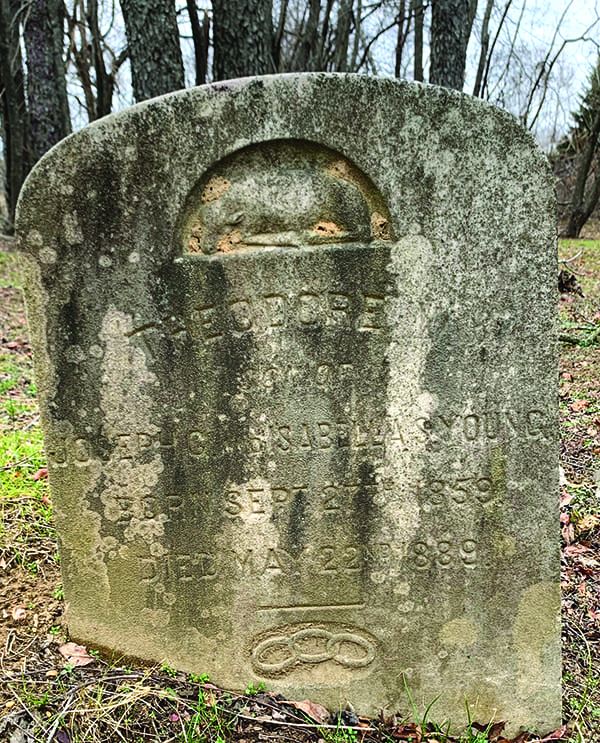
— Photo by Colleen Woods-Esposito
The clearly chiseled image of a 3-link chain is displayed on the grave of Theodore Young, who died in 1889 at age 30. The image represents bondage, and marked that Young was a slave who probably escaped to New Jersey via the Underground Railroad stop at the Mount Zion Church.
Over the years, over 200 people were buried in the cemetery, including slaves, civil war veterans, and members of Mt. Zion Church.
Ancestors of local residents are buried in the cemetery, including current Woolwich resident and Mt. Zion Church member Brenda Money. Some other names on the headstones include White, Wilson, Pennington, Thomas, Lewis, Bond, and Benton.
The cemetery is maintained by the Swedesboro V.F.W. and local Boy Scouts, and an annual Memorial Day Celebration is held at the site to honor the African American veterans who fought to protect the Union.
Although adjacent to Garwin Road and the Mount Zion Church, Mount Zion Graveyard is flanked by residential homes and only accessible by car by travelling via the small access road at the end of the cul-de-sac on Casella Way.
The Mount Zion Cemetery was the first official burial ground for inhabitants of Woolwich Township’s historic African American community, Small Gloucester.
Small Gloucester was situated about two miles northwest of the village of Swedesboro and the location is now home to Kingsway High School sports fields and residential homes.
The hamlet was founded by the anti-slavery Quakers and was one of several areas set aside in secluded Quaker land to settle African American communities in Western New Jersey. Also known as Dutchtown, it was established in the early 19th Century.
Small Gloucester was along the Underground Railroad route that included Springtown-to-Swedesboro-to-Evesham Mount (now Mount Laurel), and for over 10 years, abolitionist and political activist Harriet Tubman herself helped support this New Jersey line.
Quaker farms and the land of other anti-slavery sympathizers encircled the hamlet of Small Gloucester, and the surrounding land consisted of tributary streams, swamps, and dense woods. This ideal setting provided protection and support to the escaped slaves traveling the Underground Railroad circuit.
The Mount Zion Church, now a walkable distance from the cemetery thanks to an easement that now provides access, is where the Underground Railroad escapees were often hidden when slave hunters came searching for runaways.
Just inside the front vestibule to the left and under a carpeted floor, a 3-foot by four-foot trapdoor is hidden. Inside, a narrow opening leads to a tunnel that runs underneath the church.
William Corsey told another compelling story, this one about the trap door, and very personal.
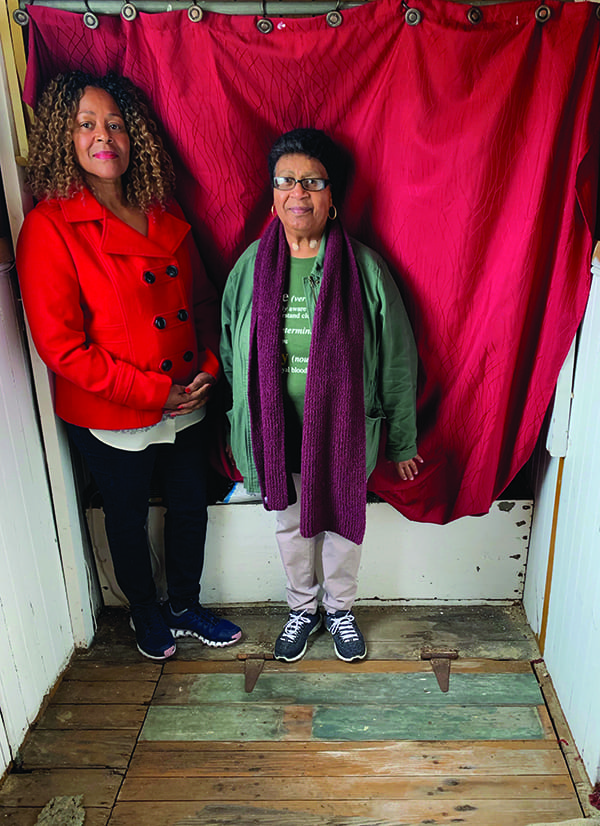
— Photo by Colleen Woods-Esposito
“I went into the trap door and shut the hatch. I stayed down there for an hour. I tried to think what it must have been like for my great-great-grandfather and great-great uncles and the other slaves who hid there.”
“I imagined what it would have been like to have to be quiet, not talk, worried that someone would find you,” he continued. “What if you had a baby that started crying?”
The small, one-story clapboard Mt. Zion Church was built in 1834 and marked the growth of the local congregation and its backing of the Underground Railroad movement. By 1850, the church supported the growing community of over 600 Small Gloucester inhabitants.
Residents banded together and supplied shelter, protection, information, and supplies to runaways. Some residents were ex-slaves themselves who had escaped and understood the plight of those for whom they risked their lives.
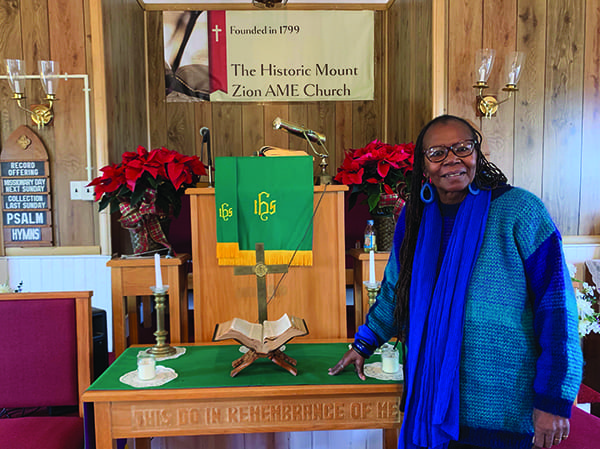
— Photo by Colleen Woods-Esposito
Today, the church, with only 10 active members, still holds full Sunday services, including a choir performance. Reverend Myrtle Daniels, a resident of Trenton, is proud to lead the flock in such an historical location.
“I find it a privilege to have the opportunity to pastor at a church so steeped in history, especially black history, at one of the oldest churches in the area, period, not just one of the oldest A.M.E. or black churches.”
Reverend Daniels invites all who love history and the church, especially young black people, to come to services.
“Come here to see how society has evolved in the last 150 years. See how the complexion has changed, in the change of ownership, the change of property, even the farming. This area used to be filled with apple trees.”
Another site important to African American history, The Richardson Avenue School, is located in downtown Swedesboro.
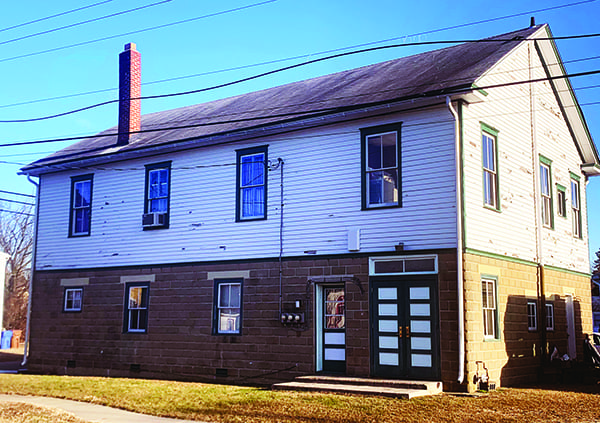
— Photo by Colleen Woods-Esposito
The site, located at the corner of Second Street and Richardson Avenue, has the distinction of being the last-standing segregated school structure in New Jersey.
“Because it’s on private land, it could not be torn down,” confirmed Sherry Hall, Board of Director of H.E.L.P., Inc, an historical and educational preservation society that is currently restoring the school, which educated African American children from 1931-1942.
As black children weren’t welcome in white schools, this “separate but equal” educational “solution” was enacted by the town of Swedesboro.
The school contained no gym, no cafeteria, no library, no fire exits, no playground, and only two restrooms for 140 students.
Because of the lack of facilities, severe overcrowding, and crumbling construction, lawyer Thurgood Marshall, who later became America’s first African American Supreme Court justice, met with the Swedesboro Board of Education to ask for improvements, but without success.
Since its closing, the building, which is now listed on state and national registers of historic sites, has housed many cultural and social activities for the African American community.
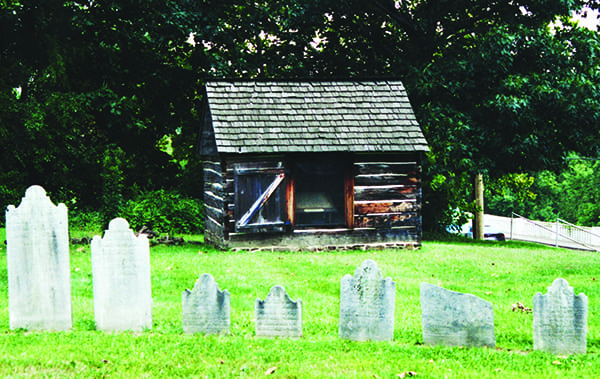
Other important African American historical sites in the area include a graveyard on Oak Grove Road in Woolwich Township and the Schorn Log Cabin, which was used as a station for the Underground Railroad before it was moved from Greenwich Township to Swedesboro. The cabin is now located in the Trinity Episcopal Cemetery on Kings Highway.
H.E.L.P., Inc. members also believe that there were Underground Railroad stops in the building of the current Blue Hen Restaurant and at the location of what is now the Head Start Preschool in Swedesboro. Hall, a resident of Woolwich Township and an English teacher by trade, talks about the volunteer work she does for H.E.L.P., Inc., and why she does it.
“Our area has rich African-American history and it should be preserved, taught, and treasured for generations.”
“It is through the stories of our ancestors, overcoming insurmountable odds, that we find strength,” she continued. “Unfortunately, our truth is too often ignored or watered down in schools.”
“When we, as a society, choose to ignore African American history, and the sacrifices made for equality, the ugly roots of institutional racism grow.”
“We must be truthful about America’s past, and never accept moral demise,” she added.
H.E.L.P., Inc. offers inspiring community programs throughout the year, including MLK Day, a black history program in February, a Memorial Day ceremony, and a Juneteenth celebration.
Tours of The Richardson Avenue School and The Mount Zion A.M.E. Church and Cemetery are available throughout the year.
For details, visit the website at www.helpinc.org. The organization also seeks volunteers to join them in preserving and promoting African American history, an integral part of American history.
By Colleen Woods-Esposito

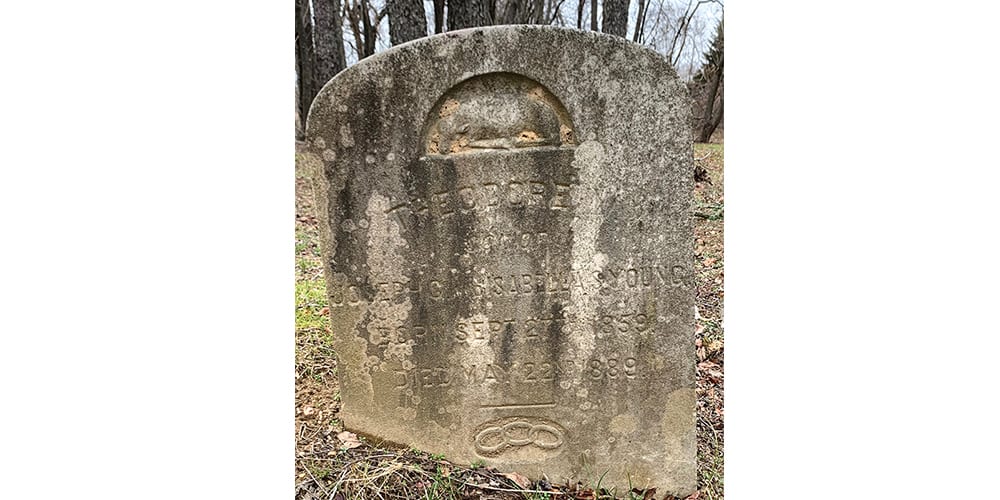





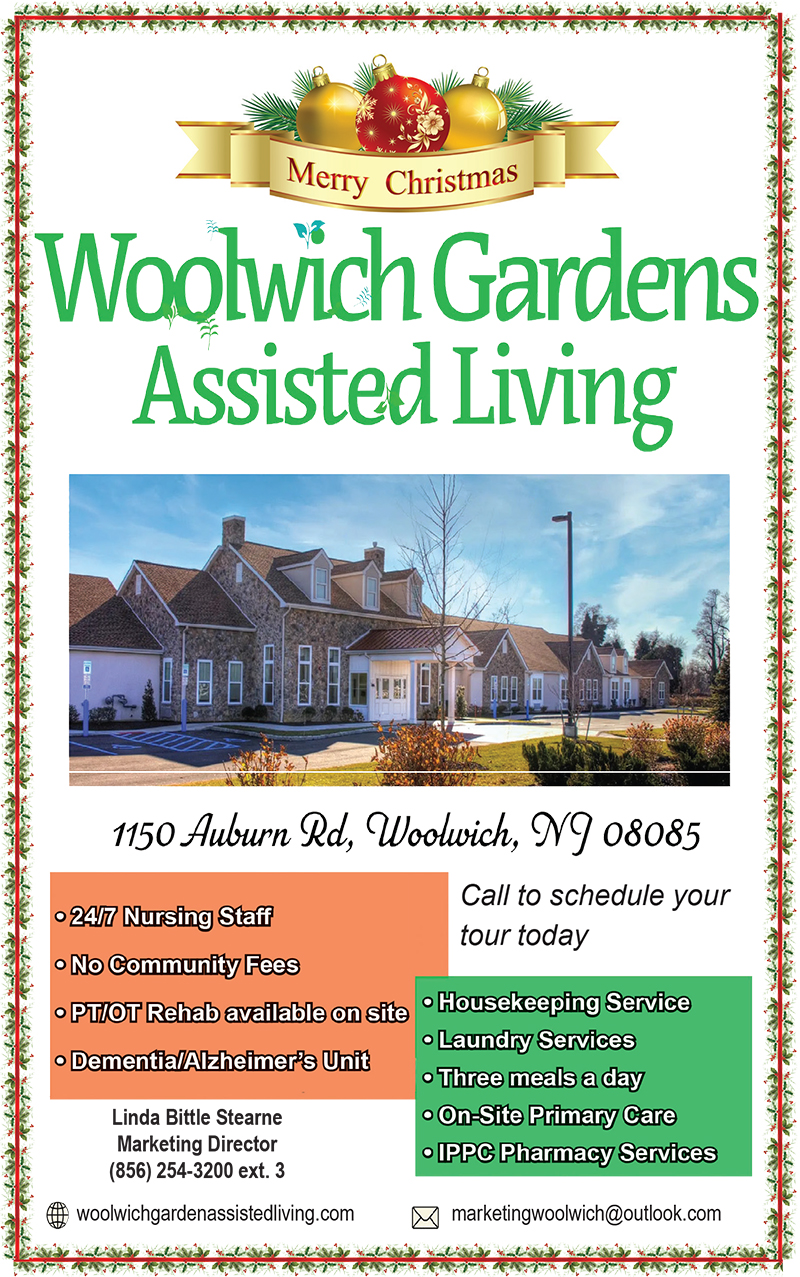




6 Responses
This article was very eye opening! We should not ignore or minimize black history in South Jersey. This important history needs to be brought to life for greater understanding. The sites need to be preserved and respected. It would be powerful if all South Jersey towns that have historic sites connected to the Underground Railroad or any slavery connections, could connect and form some kind of history tour from site to site one day a year.
Great read. Black history is right in our back yards. Thanks you
The 3 links of a chain is also the symbol of the Order of the Odd Fellows
Is this the William Corsey IV that was the track coach at deptford high school that raped 2 girls? Then his son murdered his victims boyfriend?
I do not know that.
Yup